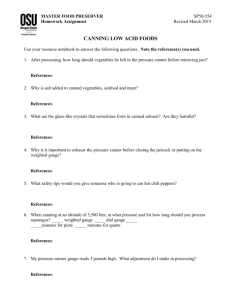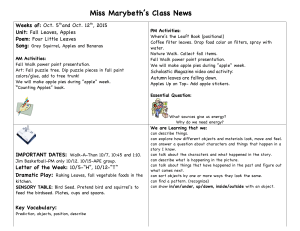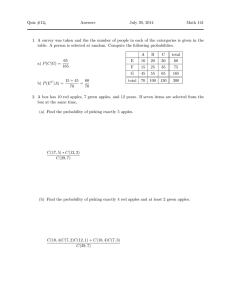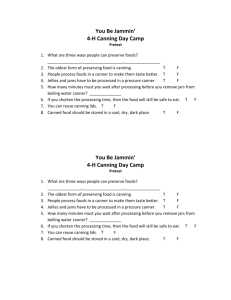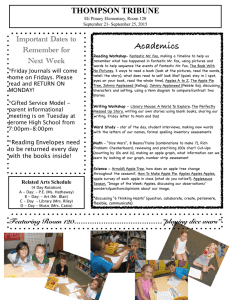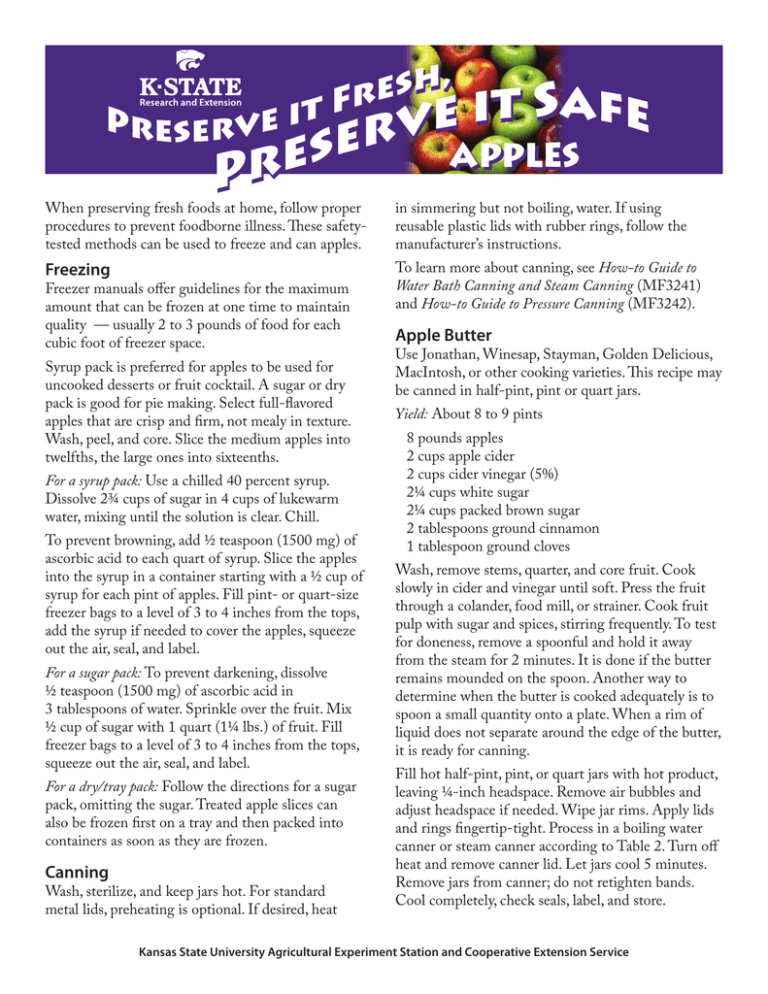
Apples
When preserving fresh foods at home, follow proper
procedures to prevent foodborne illness. These safetytested methods can be used to freeze and can apples.
Freezing
Freezer manuals offer guidelines for the maximum
amount that can be frozen at one time to maintain
quality — usually 2 to 3 pounds of food for each
cubic foot of freezer space.
Syrup pack is preferred for apples to be used for
uncooked desserts or fruit cocktail. A sugar or dry
pack is good for pie making. Select full-flavored
apples that are crisp and firm, not mealy in texture.
Wash, peel, and core. Slice the medium apples into
twelfths, the large ones into sixteenths.
For a syrup pack: Use a chilled 40 percent syrup.
Dissolve 2¾ cups of sugar in 4 cups of lukewarm
water, mixing until the solution is clear. Chill.
To prevent browning, add ½ teaspoon (1500 mg) of
ascorbic acid to each quart of syrup. Slice the apples
into the syrup in a container starting with a ½ cup of
syrup for each pint of apples. Fill pint- or quart-size
freezer bags to a level of 3 to 4 inches from the tops,
add the syrup if needed to cover the apples, squeeze
out the air, seal, and label.
For a sugar pack: To prevent darkening, dissolve
½ teaspoon (1500 mg) of ascorbic acid in
3 tablespoons of water. Sprinkle over the fruit. Mix
½ cup of sugar with 1 quart (1¼ lbs.) of fruit. Fill
freezer bags to a level of 3 to 4 inches from the tops,
squeeze out the air, seal, and label.
For a dry/tray pack: Follow the directions for a sugar
pack, omitting the sugar. Treated apple slices can
also be frozen first on a tray and then packed into
containers as soon as they are frozen.
Canning
Wash, sterilize, and keep jars hot. For standard
metal lids, preheating is optional. If desired, heat
in simmering but not boiling, water. If using
reusable plastic lids with rubber rings, follow the
manufacturer’s instructions.
To learn more about canning, see How-to Guide to
Water Bath Canning and Steam Canning (MF3241)
and How-to Guide to Pressure Canning (MF3242).
Apple Butter
Use Jonathan, Winesap, Stayman, Golden Delicious,
MacIntosh, or other cooking varieties. This recipe may
be canned in half-pint, pint or quart jars.
Yield: About 8 to 9 pints
8 pounds apples
2 cups apple cider
2 cups cider vinegar (5%)
2¼ cups white sugar
2¼ cups packed brown sugar
2 tablespoons ground cinnamon
1 tablespoon ground cloves
Wash, remove stems, quarter, and core fruit. Cook
slowly in cider and vinegar until soft. Press the fruit
through a colander, food mill, or strainer. Cook fruit
pulp with sugar and spices, stirring frequently. To test
for doneness, remove a spoonful and hold it away
from the steam for 2 minutes. It is done if the butter
remains mounded on the spoon. Another way to
determine when the butter is cooked adequately is to
spoon a small quantity onto a plate. When a rim of
liquid does not separate around the edge of the butter,
it is ready for canning.
Fill hot half-pint, pint, or quart jars with hot product,
leaving 1/4-inch headspace. Remove air bubbles and
adjust headspace if needed. Wipe jar rims. Apply lids
and rings fingertip-tight. Process in a boiling water
canner or steam canner according to Table 2. Turn off
heat and remove canner lid. Let jars cool 5 minutes.
Remove jars from canner; do not retighten bands.
Cool completely, check seals, label, and store.
Kansas State University Agricultural Experiment Station and Cooperative Extension Service
Apple Jelly
Apple Pie Filling
Yield: 4 half-pints
This fruit filling is an excellent and safe product. Each
canned quart makes one 8- to 9-inch pie. Fillings
may be used as toppings on desserts or pastries. Clear
Jel® is a starch modified to produce excellent sauce
consistency even after fillings are canned and baked.
Other cooking starches are not recommended as
they break down, causing a runny sauce consistency.
(Clear Jel® is available from bulk food stores or on the
Internet.)
4 cups apple juice (about 3 pounds of apples and
3 cups of water)
2 tablespoons lemon juice, optional
3 cups sugar
To prepare juice: Select about one-fourth slightly under
ripe apples and three-fourths fully ripe apples. Sort,
wash, and remove stems and blossom ends; do not
peel or core. Cut the apples into small pieces. Add
water, cover, and bring to a boil on high heat.
Because the variety of fruit may alter the flavor of the
fruit pie, you should first make a single quart, make a
pie, and serve it. Then adjust sugar and spices to suit
your personal preference. The amount of lemon juice
should not be altered, because it aids in ensuring the
safety and storage stability of the fillings. If the filling
is too tart, add more sugar to taste.
Apple Pie Filling
Reduce heat and simmer for 20 to 25 minutes or until
apples are soft. Extract juice through a damp jelly bag
or four thicknesses of cheesecloth. Avoid squeezing
pulp to obtain clear juice.
To make jelly: Measure apple juice into a saucepan.
Add lemon juice and sugar, and stir to dissolve sugar.
Boil over high heat, stirring constantly, to 8°F above
the boiling point of water or until the jelly mixture
sheets from a spoon.
Ingredient
Blanched, sliced fresh
apples
Granulated sugar
Clear Jel®
Cinnamon
Cold water
Apple juice
Bottled lemon juice
Nutmeg (optional)
Yellow food
coloring (optional)
Remove from heat; skim off foam quickly. Pour jelly
immediately into hot, sterilized jars, leaving ¼-inch
headspace. Wipe jar rims. Apply lids and rings
fingertip-tight. Process in a boiling water canner or
steam canner according to Table 2. Turn off heat and
remove canner lid. Let jars cool 5 minutes. Remove
jars from canner; do not retighten bands. Cool
completely, check seals, label and store.
Apple Juice
Good quality apple juice is made from a blend of
varieties. For best results, buy fresh juice from a local
cider maker within 24 hours after it has been pressed.
Q uantities of ingredients needed for:
1 quart
7 quarts
3½ cups
6 quarts
¾ cup + 2 tablespoons
¼ cup
½ teaspoon
½ cup
¾ cup
2 tablespoons
1/8 teaspoon
1 drop
5½ cups
1½ cups
1 tbsp.
2½ cups
5 cups
¾ cup
1 teaspoon
7 drops
Use firm, crisp apples; Stayman, Golden Delicious,
Rome, and other cooking varieties are suitable. If
apples lack tartness, use an additional ¼ cup of lemon
juice for each 6 quarts of slices.
Refrigerate juice for 24 to 48 hours. Without
mixing, carefully pour off the clear liquid and discard
sediment. Strain clear liquid through a paper coffee
filter or double layers of damp cheesecloth. Heat
quickly, stirring occasionally, until juice begins to
boil. Fill immediately into hot, sterile pint, quart, or
half-gallon jars, leaving ¼-inch headspace. Wipe jar
rims. Apply lids and rings fingertip-tight. Process
in a boiling water canner or steam canner according
to Table 2. Turn off heat and remove canner lid. Let
jars cool 5 minutes. Remove jars from canner; do not
retighten bands. Cool completely, check seals, label,
and store.
Wash, peel, and core apples. Cut apples into slices,
½-inch wide, and place them in water containing
ascorbic acid to prevent browning. Use 1 teaspoon of
ascorbic acid crystals or six 500 mg. vitamin C tablets
(crushed) in 1 gallon of water. Blanch apples by
placing 6 cups at a time in 1 gallon of boiling water.
Boil each batch 1 minute after the water returns to
a boil. Drain fruit and keep hot in a covered bowl or
pot. Combine sugar, Clear Jel®, and cinnamon in a
large kettle with water and apple juice. If desired, food
coloring and nutmeg may be added. Stir and cook on
a medium high heat until mixture thickens and begins
2
to bubble. Add lemon juice and boil 1 minute, stirring
constantly. Fold in drained apple slices immediately
and fill hot pint or quart jars with the mixture without
delay, leaving 1-inch headspace. Remove air bubbles
and adjust headspace if needed. Wipe jar rims. Apply
lids and rings fingertip-tight. Process immediately
according to directions in Table 2. Turn off heat and
remove canner lid. Let jars cool 5 minutes. Remove
jars from canner; do not retighten bands. Cool
completely, check seals, label, and store.
according to directions in Table 2 or in a pressure
canner following guidelines in Table 3. Turn off heat
and remove canner lid. If pressure canning, let the
canner depressurize naturally, then remove lid. Let
jars cool 5 minutes. Remove jars from canner; do not
retighten bands. Cool completely, check seals, label,
and store.
Apples – Sliced Rings
An average of 19 pounds is needed per canner load
of 7 quarts; an average of 12¼ pounds is needed per
canner load of 9 pints. A bushel weighs 48 pounds
and yields 16 to 19 quarts — an average of 2¾ pounds
per quart. Select apples that are juicy, crispy, and
preferably both sweet and tart.
Applesauce
An average of 21 pounds is needed per canner load
of 7 quarts; an average of 131⁄2 pounds is needed per
canner load of 9 pints. A bushel weighs 48 pounds
and yields 14 to 19 quarts of sauce — an average of
3 pounds per quart. Select apples that are sweet, juicy,
and crisp. For a tart flavor, add 1 to 2 pounds of tart
apples to each 3 pounds of sweeter fruit.
Wash, peel, and core apples. To prevent discoloration,
slice apples into water containing ascorbic acid. Use
1 teaspoon of ascorbic acid crystals or six 500 mg.
vitamin C tablets (crushed) in 1 gallon of water.
Wash, peel, and core apples. Slice apples into water
containing ascorbic acid to prevent browning. Use
1 teaspoon of ascorbic acid crystals or six 500 mg.
vitamin C tablets (crushed) in 1 gallon of water. Place
drained slices in an 8- to 10-quart pot. Add ½ cup of
water. Stirring occasionally to prevent burning, heat
quickly until tender (5 to 20 minutes, depending on
the maturity and variety).
Raw packs make poor quality products. Place drained
slices in a large saucepan and add 1 pint of water or
very light, light, or medium syrup per 5 pounds of
sliced apples. Use Table 1 to make the syrup. Boil for
5 minutes, stirring occasionally to prevent burning.
Fill hot jars with hot slices and hot syrup or water,
leaving ½-inch headspace. Remove air bubbles and
adjust headspace if needed. Wipe jar rims. Apply
lids and rings fingertip-tight. Process in a boiling
water canner or steam canner according to Table 2 or
pressure canner according to Table 3. Turn off heat
and remove canner lid. If pressure canning, let the
canner depressurize naturally, then remove lid. Let
jars cool 5 minutes. Remove jars from canner; do not
retighten bands. Cool completely, check seals, label,
and store.
Press through a sieve or food mill, or skip the pressing
step if you prefer chunk-style sauce. Sauce may be
packed without sugar. If desired, add ⅛ cup of sugar
per quart of sauce. Taste and add more, if preferred.
Reheat sauce to boiling.
Fill hot jars with hot sauce, leaving ½-inch headspace.
Remove air bubbles and adjust headspace if needed.
Wipe jar rims. Apply lids and rings fingertip-tight.
Process in a boiling water canner or steam canner
Table 1. Measures of water and sugar in preparing and using syrups
Syrup type
Very light
Light
Medium
Approximate percent of sugar
10
20
30
*This amount is also adequate for a 4-quart load.
For 9-pint load*
Cups of water
Cups of sugar
For 7-quart load
Cups of water
Cups of sugar
6½
5¾
5¼
¾
1½
2¼
10½
9
8¼
1¼
2¼
3¾
3
Using a blancher basket or sieve, immerse one-third
of the apples at a time in the boiling vinegar/syrup
solution for 2 minutes. Place cooked apples and spice
bag in a clean 1- or 2-gallon crock and add the hot
syrup. Cover and let stand overnight. Remove spice
bag; drain syrup into a large saucepan and reheat to
boiling.
Spiced Apple Rings
Yield: About 8 to 9 pints
12 pounds firm tart apples (maximum diameter is
2½ inches)
12 cups sugar
6 cups water
1¼ cups white vinegar (5%)
3 tablespoons whole cloves
¾ cup red hot cinnamon candies or
8 cinnamon sticks and
1 teaspoon red food coloring (optional)
Fill hot pint jars with apples and hot syrup, leaving
½-inch headspace. Remove air bubbles and adjust
headspace if needed. Wipe jar rims. Apply lids and
rings fingertip-tight. Process in a boiling water canner
or steam canner according to directions in Table 1.
Turn off heat and remove canner lid. Let jars cool 5
minutes. Remove jars from canner; do not retighten
bands. Cool completely, check seals, label and store.
Wash, peel and slice apples. Immediately cut crosswise
into ½-inch slices, remove core area with a melon
baller. Immerse in an ascorbic acid solution. Use
1 teaspoon of ascorbic acid crystals or six 500 mg
vitamin C tablets (crushed) in 1 gallon of water.
Crabapple Jelly Without Added Pectin
Yield: About 5 or 6 half-pint jars
To make a flavored syrup, combine sugar, water,
vinegar, cloves, cinnamon candies or cinnamon sticks,
and food coloring in a 6-quart saucepan. Stir, heat to
boil, and simmer for 3 minutes. Drain apples, add to
the hot syrup, and cook for 5 minutes.
4 cups crabapple juice (about 3 pounds of crabapples
and 3 cups water)
4 cups sugar
To prepare juice: Select firm, crisp crabapples, about
¼ firm ripe and ¾ fully ripe. Sort, wash and remove
stem and blossom ends; do not pare or core. Cut
crabapples into small pieces. Add water, cover and
bring to boil on high heat. Stir to prevent scorching.
Reduce heat and simmer for 20 to 25 minutes, or
until crabapples are soft. Do not overcook; excess
boiling will destroy the pectin, flavor and color. When
fruit is tender, pour everything through a double
layer of dampened cheesecloth or a damp jelly bag.
Suspend the bag over a bowl or pan, using a stand
or colander to hold the bag. Drain the juice without
pressing or squeezing, which will cause cloudy jelly.
If a fruit press is used, the juice should be restrained
through a jelly bag.
Fill hot jars (preferably wide-mouth) with apple rings
and hot flavored syrup, leaving ½-inch headspace.
Remove air bubbles and adjust headspace if needed.
Wipe jar rims. Apply lids and rings fingertip-tight.
Process in a boiling water canner or steam canner
according to Table 2. Turn off heat and remove canner
lid. Let jars cool 5 minutes. Remove jars from canner;
do not retighten bands. Cool completely, check seals,
label and store.
Spiced Crab Apples
Yield: About 9 pints
5 pounds crab apples
4½ cups apple vinegar (5%)
3¾ cups water
7½ cups sugar
4 teaspoons whole cloves
4 sticks cinnamon
Six ½-inch cubes of fresh ginger root
To prepare jelly: Measure juice into saucepot. Add
sugar and stir well. Boil over high heat until temperature measures 8°F above the boiling point of water
(220°F at sea level), or the jelly mixture sheets from a
metal spoon. Remove from heat; skim foam quickly.
Pour hot jelly immediately into hot, sterile jars, leaving ¼-inch headspace. Wipe jar rims. Apply lids and
rings fingertip-tight. Process in a boiling water canner
or steam canner according to directions in Table 2.
Turn off heat and remove canner lid. Let jars cool 5
minutes. Remove jars from canner; do not retighten
bands. Cool completely, check seals, label, and store.
Remove blossom petals and wash apples, but leave
stems attached. Puncture the skin of each apple four
times with an ice pick or toothpick. Mix vinegar,
water, and sugar, and bring to a boil. Add spices tied
in a spice bag or cheesecloth.
4
3 tablespoons mustard seed
2 tablespoons ground ginger
2 tablespoons ground allspice
2 teaspoons canning salt
1 clove garlic, crushed
1 quart white vinegar (5%)
Combine all ingredients; simmer until thick, about
1 hour and 15 minutes. As mixture thickens stir
frequently to prevent sticking.
Reduced Sugar Apple Butter
Yield: About 4 to 5 half-pint jars.
4 pounds apples
1 cup apple cider
½ cup Splenda®
1 tablespoon ground cinnamon
¼ teaspoon ground cloves
½ teaspoon ground allspice
Wash apples well and remove stems. Cut apples into
quarters or eighths and remove cores.
Pour boiling hot chutney into hot jars, leaving ½-inch
headspace. Remove air bubbles and adjust headspace
if needed. Wipe jar rims. Apply lids and rings
fingertip-tight. Process in a boiling water canner or
steam canner according to Table 2. Turn off heat and
remove canner lid. Let jars cool 5 minutes. Remove
jars from canner; do not retighten bands. Cool
completely, check seals, label and store.
Combine unpeeled apples and cider in 8-quart
saucepan. Cook slowly and stir occasionally to prevent
sticking. Cook until apples are very soft (falling
apart).
Position a food mill or strainer securely over a large
bowl. Press cooked apples with cider through the
food mill or strainer to make a pulp. Be sure to collect
all the pulp that comes through the food mill or
strainer; for example, scrape any pulp clinging under
the food mill into the bowl.
Harvest Time Apple Relish
Yield: About 7 to 8 pint jars
8 pounds apples (crisp cooking variety such as
Honey Crisp, Cameo, or Pink Lady)
3 cups distilled white vinegar (5%)
2½ cups sugar
2 cups water
2 teaspoons ground cloves
8 pieces stick cinnamon (3 inches each)
1 tablespoon ground allspice
4 teaspoons ground ginger
4 t ablespoons (¼ cup) finely chopped red Serrano
pepper (about 4-6 peppers as purchased)
Combine pulp with Splenda® and spices in an
8-quart saucepan. Simmer over low heat, stirring
frequently. To test for doneness, spoon a small
quantity onto a clean plate; when the butter mounds
on the plate without liquid separating around the
edge of the butter, it is ready for processing. Another
test for doneness is to remove a spoonful of cooked
butter away from steam for 2 minutes. It is done if the
butter remains mounded on the spoon.
Fill hot apple butter into clean hot jars, leaving
¼-inch headspace. Wipe jar rims. Apply lids and
rings fingertip-tight. Process in a boiling water canner
or steam canner according to directions in Table 2.
Turn off heat and remove canner lid. Let jars cool 5
minutes. Remove jars from canner; do not retighten
bands. Cool completely, check seals, label and store.
Caution: Wear plastic or rubber gloves and do not
touch your face while handling or cutting hot peppers.
If you do not wear gloves, wash hands thoroughly
with soap and water before touching your face or eyes.
Rinse apples well, peel if desired for best quality,
and core. Immerse prepared apples in a solution
of 1 teaspoon ascorbic acid and 4 quarts of water
to prevent browning. Coarsely shred with food
processor or dice by hand and return to ascorbic acid
bath as you work.
Apple Chutney
Yield: About 6 pint jar
2 quarts chopped, cored, pared tart apples (about
10 medium)
1 cup chopped onions
1 cup chopped sweet red bell peppers (about
2 medium)
2 hot red peppers, seeded and chopped
1½ pounds seedless raisins
4 cups brown sugar
Rinse peppers and remove stem ends; trim to remove
seeds then finely chop.
Combine vinegar, sugar, water, cloves, cinnamon
sticks, allspice, ginger and red pepper. Heat while
stirring to dissolve sugar; bring to a boil.
5
Drain apples and add to hot syrup. Bring back to a
boil. Boil gently 5 minutes, stirring occasionally, until
apples are mostly translucent. Turn off heat. Remove
cinnamon sticks from relish mixture and place one
piece in each jar.
with syrup. Remove air bubbles and adjust headspace
if needed. Wipe jar rims. Apply lids and rings
fingertip-tight. Process in a boiling water canner or
steam canner according to the guidelines in Table 2.
Turn off heat and remove canner lid. Let jars cool 5
minutes. Remove jars from canner; do not retighten
bands. Cool completely, check seals, label, and store.
Fill hot fruit with syrup into hot jars, leaving ½-inch
headspace, making sure fruit is completely covered
Table 2. Recommended processing times in a water bath canner or steam canner
Product
Apple butter
Hot-pack processing times in minutes at different altitudes (in feet)
0-1,000
1,001-3000
3,001-6,000
Jar size
Half-pints or pints
Quarts
Apple jelly
Half-pints or pints
Apple juice
Pints or quarts
Half-gallons
Apple pie filling
Pints or quarts
Applesauce
Pints
Quarts
Sliced apples
Pints or quarts
Spiced apple rings
Half-pints or pints
Spiced crab apples
Pints
Crabapple jelly
Half-pints or pints
Reduced-sugar apple butter Half-pints or pints
Apple chutney
Pints
Harvest Time Apple Relish Half-pints or pints
5
10
5
5
10
25
15
20
20
10
20
5
15
10
10
10
15
10
10
15
30
20
25
25
15
25
10
20
15
15
10
15
10
10
15
35
20
30
30
15
30
10
20
15
15
Table 3. Recommended hot-pack processing times in a pressure canner
Product
Sliced Apples
Applesauce
Jar Size
Pints or Quarts
Pints
Quarts
Process Time (min.)
Canner gauge pressure at different altitudes (in feet)
Dial gauge
Weighted gauge
0-2,000
2,001-4,000
1-1,000
8
8
10
6
6
6
6
7
7
7
5
5
5
Above 1,000
10
10
10
Nutrition Information
Apples
Apple butter
Apple jelly
Apple juice
Apple pie filling
Applesauce (sweetened)
Applesauce (unsweetened)
Apples – sliced rings
Spiced apple rings
Spiced crab apples
Crabapple jelly
Reduced sugar apple butter
Apple chutney
Harvest Time Apple Relish
Serving size
1 tablespoon
1 tablespoon
½ cup
1/8 of pie
½ cup
½ cup
1 cup
½ cup
½ cup
1 tablespoon
1 tablespoon
1 tablespoon
1 tablespoon
Calories
Fat (g)
29
50
57
74
84
51
137
180
190
40
15
30
15
0.0
0.0
0.0
0.0
0.0
0.0
1.0
0.0
0.0
0.0
0.0
0.0
0.0
Problems and Solutions
1. After canning apples, why do they float?
The fruit is lighter than the sugar syrup. Use firm,
ripe fruit. Use the hot pack method to remove air
from the fruit. Use a light or medium syrup instead
of a heavy syrup. Pack fruit as close as possible and
release trapped air before applying the lid.
2. Can apples be canned without sugar?
Yes. Sugar is added to improve flavor, help stabilize
color, and retain the shape of the fruit. It is not
added as a preservative.
3. How do you make homemade pectin?
Homemade liquid pectin is made from tart
cooking apples that are slightly underripe or from
crab apples. Directions can be found at http://
extension.oregonstate.edu/lane/sites/default/files/
images/sp50778.pdf.
4. How are apples dried?
Directions for drying apples and many other fruits
can be found at www.rrc.ksu.edu.
5. How can I reduce the amount of foaming in
jelly?
Add ½ teaspoon butter or margarine to the fruit
mixture before boiling.
Carbohydrates (g) Fiber (g)
7.2
13.0
14.0
19.4
21.5
13.75
34.07
47.0
49.0
11.0
3.0
8.0
4.0
0.05
0.0
0.2
0.75
1.5
1.3
3.5
1.0
1.0
0.0
0.0
0.0
0.0
Vit. C (mg)
Sodium (mg)
0.1
0.0
1.1
1.3
2.1
1.2
0.8
3.6
4.8
0.0
0.0
2.4
0.8
3.0
0.0
5.0
35.0
2.0
2.0
6.0
0.0
0.0
0.0
0.0
25.0
0.0
Revised by Karen Blakeslee, M.S., Extension Associate, Food Science
Adapted from original by Karen P. Penner, Ph.D., and Jeanne Dray, April 1995
Complete Guide to Home Canning, USDA AIB No. 539, 2009; and So Easy to Preserve, 6th ed., The University of Georgia Cooperative Extension Service.
Brand names appearing in this publication are for product identification purposes only. No endorsement is intended,
nor is criticism implied of similar products not mentioned.
Publications from Kansas State University are available at www.ksre.ksu.edu
Publications are reviewed or revised annually by appropriate faculty to reflect current research and practice. Date shown is that of publication or last revision. Contents of this
publication may be freely reproduced for educational purposes. All other rights reserved. In each case, credit
Karen Blakeslee, et al., Preserve it Fresh, Preserve it Safe Apples, Kansas State University, December 2015.
Kansas State University Agricultural Experiment Station and Cooperative Extension Service
MF1187 — December 2015
K-State Research and Extension is an equal opportunity provider and employer. Issued in furtherance of Cooperative Extension Work, Acts of May 8 and June 30, 1914,
as amended. Kansas State University, County Extension Councils, Extension Districts, and United States Department of Agriculture Cooperating, John. D. Floros, Director.


